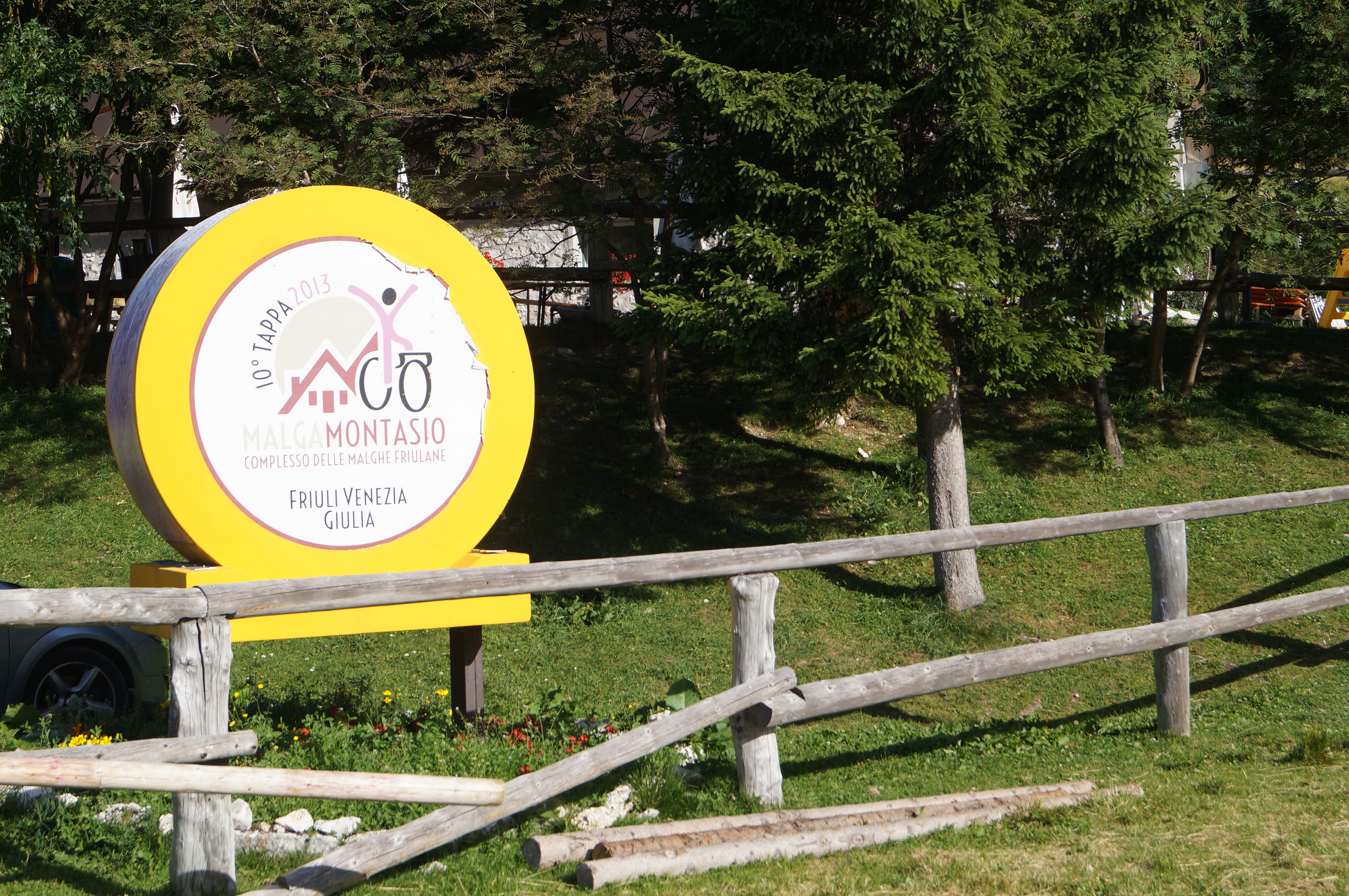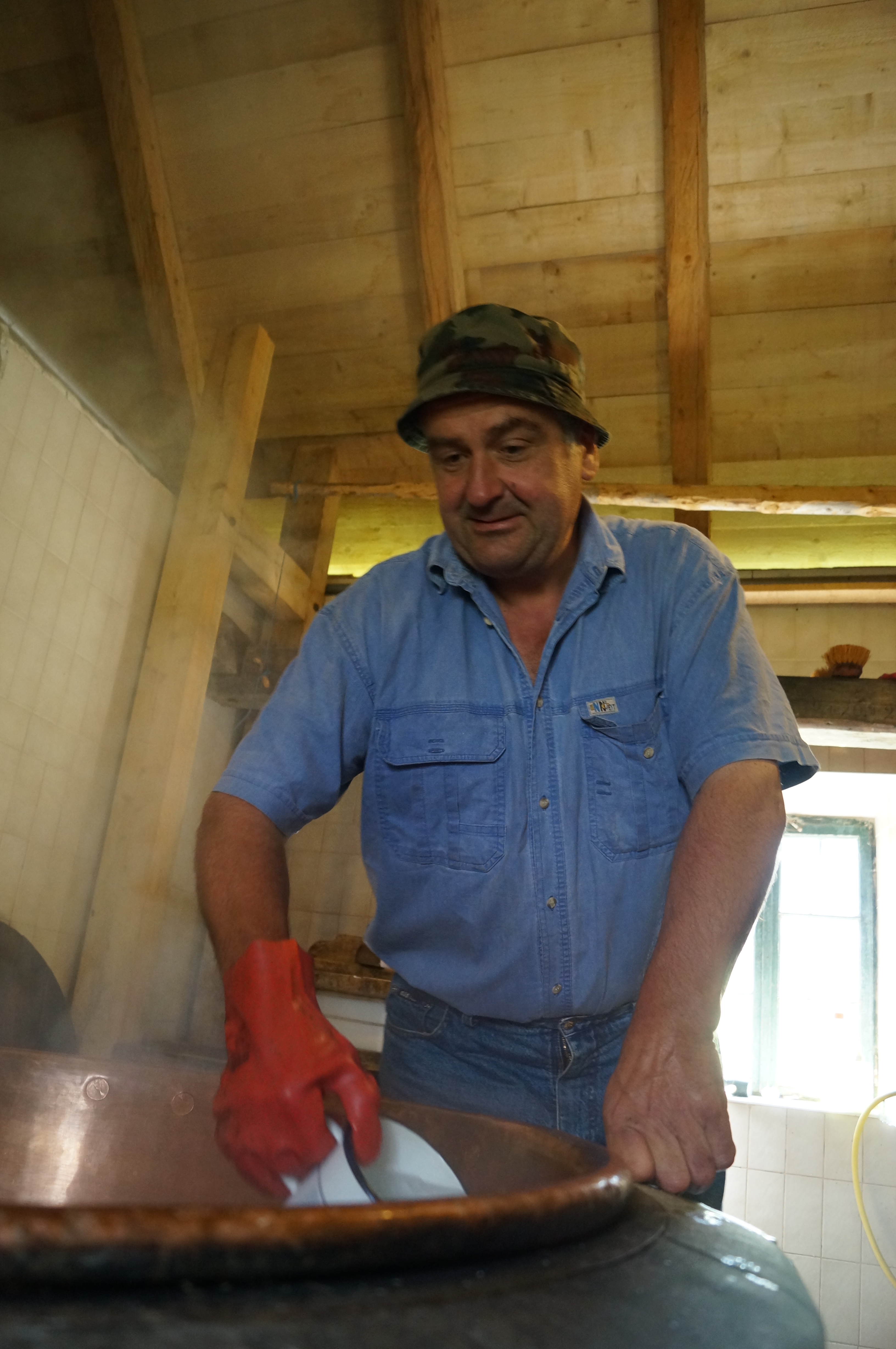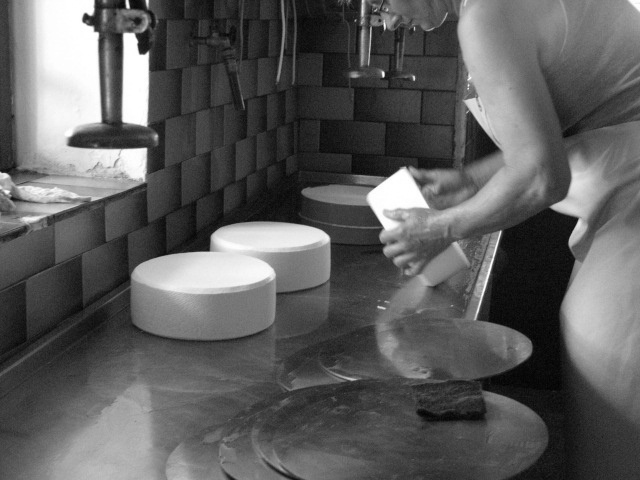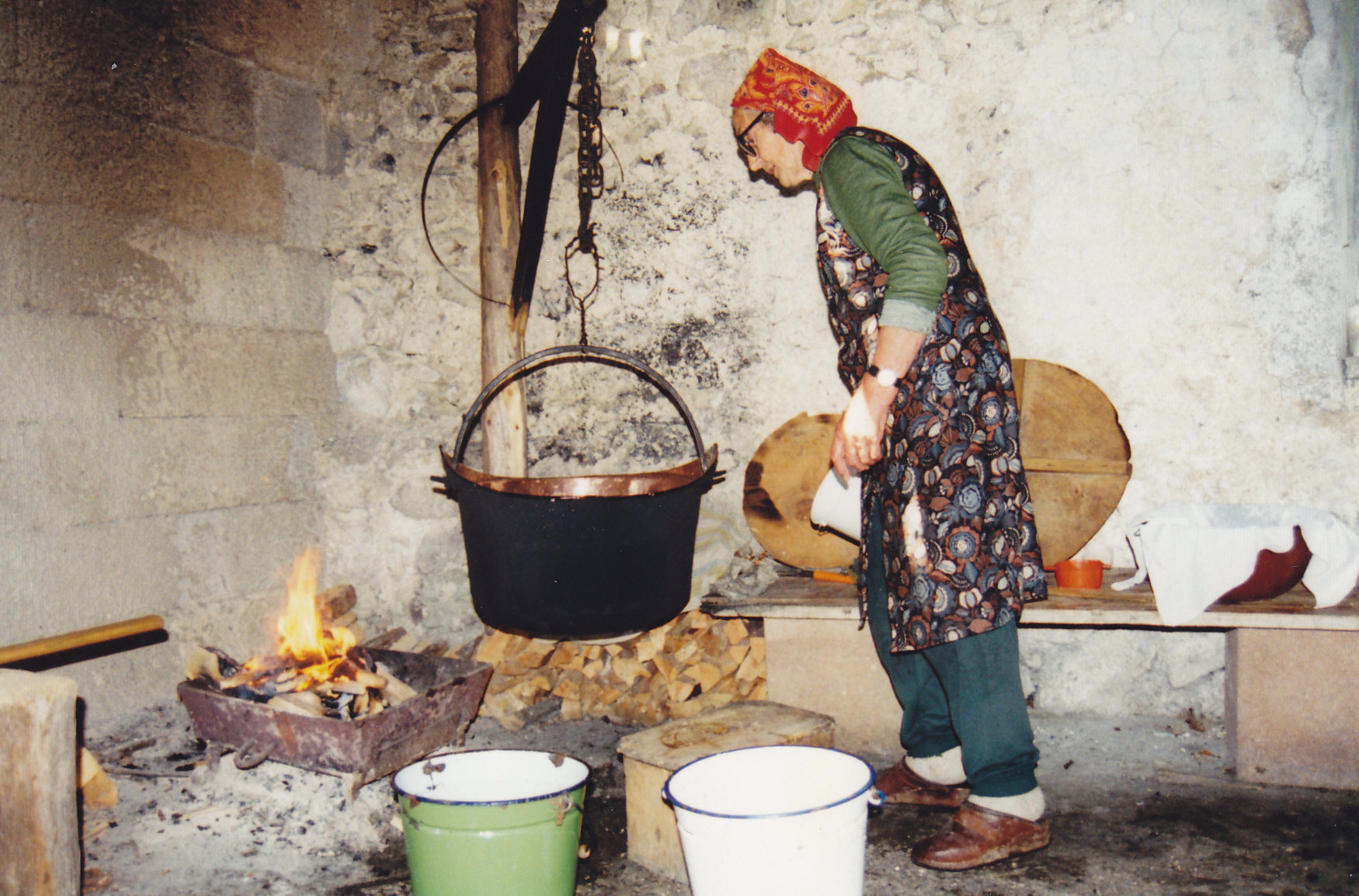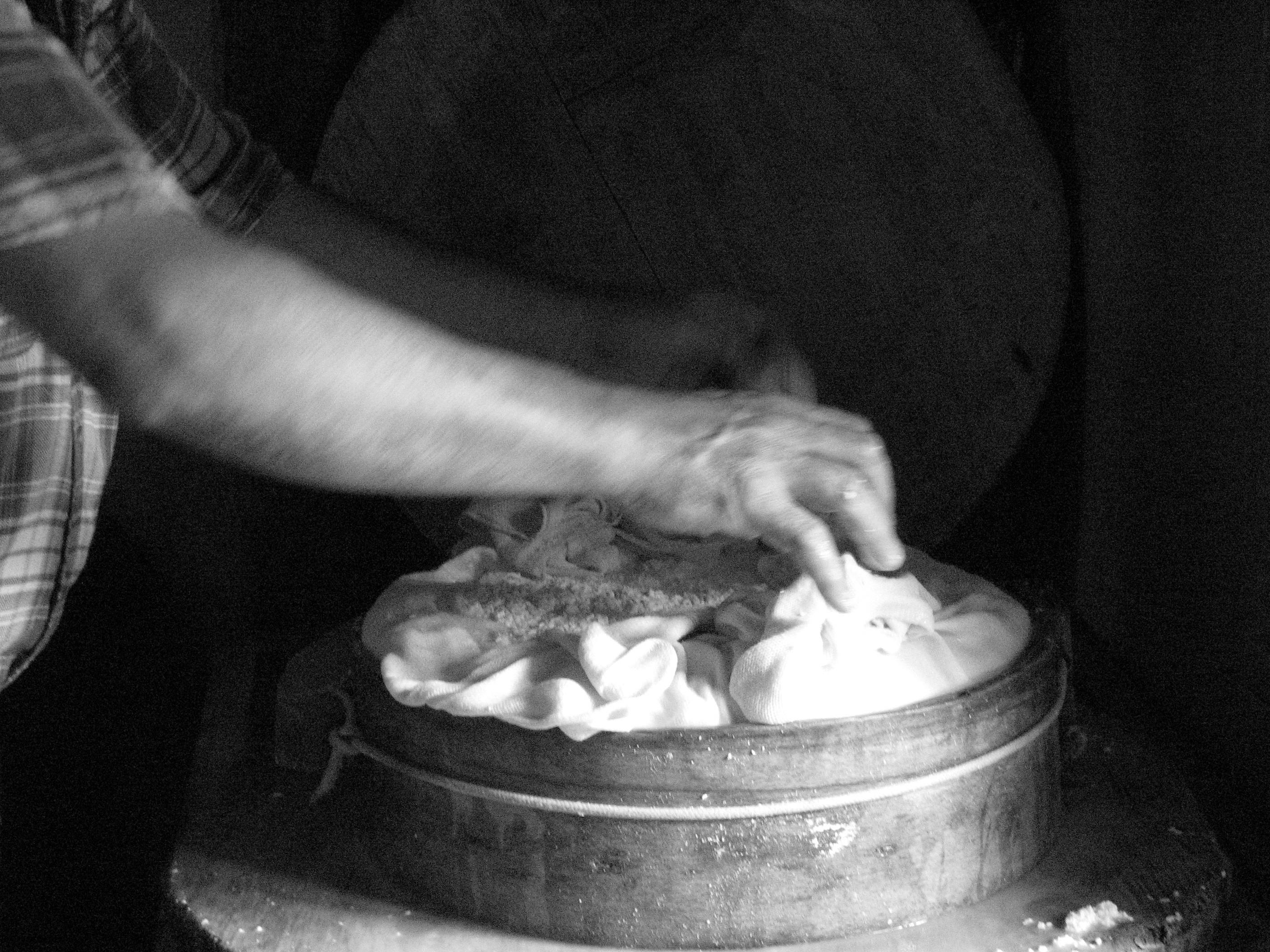INTRODUCTION
The aim of this article is to present the state of (traditional) dairying knowledge in the mountain pastures1 of the Julian Alps. In the first part, I will outline a brief history of Alpine husbandry, mountain pasture and dairying, i.e. the past elements and practices of which some are today considered (cultural) heritage. In the second part, I will discuss utopias and realities of contemporary Alpine pasture dairying practices that are confronted with issues of heritagization processes, oxymoronic sustainable development and EU Common Agricultural Policy. Findings in this article are based on the intensive participant observation during the grazing seasons of 1998 and 1999, and on continuous sporadic fieldwork in different alps and conversations with different stakeholders up until today. The interpretation of these findings is based on and compared to the findings ofCristina Grasseni (2011) in the Italian North-Western Alps and ofSarah May (2014) in the German Alps.
HERITAGES
In mountain environments, where agricultural activities are constrained by climatic effects of altitude, edaphic factors, scarcity of soil and steep gradients of the land, pastoralism has always been the most effective and dominant agricultural activity. Large expanses of grasslands, which ring the valleys between the tree line and the glaciers, could be made accessible for productive activities because of animals’ ability to convert natural plants into nutritive food (Viazzo 1989:19). A combination of cultivation and herding, known as Alpine husbandry or Alpine agro-pastoral system, consisted of two (or more) spatially segregated spheres of production: fields and meadows near the village, and the alps, i.e. high-altitude pastures, which during the summer offered grazing for cattle, sheep and goats. In Slovenian, these alps are known as planine or planšarije, in Italian as alpi, alpeggi or malghe, in Friulian as mont, and in German as Almen or Alpen. The term is of Pre-Roman origin and designates not only pastures, but also huts, stalls and sometimes even dairies that were occupied by animals, herders and eventually dairymen in the summer months. Herders and cattle would not move directly from the village to the alps; instead, they would first transfer to granges in the higher meadows (rovt in Slovenian), which were used for grazing in combination with haying and perhaps some cultivation. After a couple of weeks, the livestock was moved to the lower alps, where the animals would stay from two to four weeks before they were transferred to the upper alps, where they would spend the peak season. In September, they would again descend to the lower alps, then to granges and finally to the villages (Cole and Wolf 1999:119-152;Netting 1981:19;Viazzo 1989:20).
Breeding and transhumance of livestock in the Alps had existed as early as prehistory and antiquity; its existence in the Eastern Alps was proven by archaeological finds as well as the etymology of toponyms and pasture and dairying terms (Cevc 2006:113–121;Mandl 2007:Novak 1961:126–128). The archaeological finds of vessels with holes (hypothesized to be cheese drainers) demonstrate that cheese-making technology in the Eastern Alps was already known in the Roman period (Cevc 2006:243–246); however, it has not been proven if cheese was in fact made in the mountain pastures. There are similar etymological legends in several Alpine regions explaining how shepherds were taught to make cheese by the savage man. They are supposed to have preserved the tradition that the Indo-European peoples of the Apennine peninsula and the Alps learnt how to make cheese from the early inhabitants (Cevc 2006:242;Grafenauer 1958:50–51;Matičetov 1972:87–94). Linguistic and legal history research supports the assumption that the (Romanized) inhabitants of the region already possessed dairying knowledge which they later transmitted to the newcomers in the Eastern Alps (Novak 1961:123–134).
Payments in cheese for hiring a mountain pasture during the summer season, which were documented in the written sources of the Patriarchs of Aquileia, prove that cheese had been processed from milk in mountain pastures of the Julian Alps as early as the 13th century (Cevc 2006: 248–249;Kos 1948:30–32;Melik 1950:97–101;Pascolini and Tessarin 1985:51–52;Vilfan 1996:228).2 Also the archaeological finds of torilo, i.e. a perforated cheese-draining piece of pottery, and shallow bowls from the alps attest to the existence of dairying at the end of the Middle Ages (Cevc 2006:251). It is believed that in that period, cheese was made from sour sheep milk (Bitterli-Waldfogel 1999:110).
Dairying became even more significant within the Modern Age physiocratic efforts of the Austrian Monarchy in the 19th century. Communal herding3and land tenure – which were common for the upper alps, but not the lower alps and high meadows – were practiced by means of communal butter and cheese production. The basis for distribution of cheese or income was the quantity of milk produced after the cattle had been grazing on the mountain pasture on the measuring day (Ložar 1944:168–171). Members of the community later organised themselves in cooperatives. The predecessors of such cooperatives date back to the end of the 18th and early 19th century. In the second half of the 19th century, the Austrian Imperial Royal Ministry of Agriculture accelerated Alpine dairy farming, cattle in particular, and offered support and incentives for the improvement of the mountain pasture economy and the promotion of dairying (Valenčič 1990:31–42). The regional agricultural societies published professional literature (e.g. Trientl 1872;Wilhelm 1871), invited experts from Switzerland to teach the local cheesemakers about Swiss dairying (Povše 1870:18–17), and encouraged farmers to establish and join dairy cooperatives. These were established in order to improve the quality of production in accordance with strict rules regarding quantity, quality and hygiene of the delivered milk, and increase the profit (Valenčič 1990:32–37). In the late 19th century, the eventual individual production of butter, cheese from sour milk and cottage cheese was substituted by more profitable common dairying under the supervision of a hired skilled cheese-maker and sweet milk cheese production (Ledinek Lozej 2013a:67–77;Novak 1987:77–78; 1989;Taborra 2008: 26;Valenčič 1990:33–37). 4
In the first half of the 20th century, competent state agencies proceeded to promote efficient dairying by publishing handbooks (Pevc 1925;1926;Spiller-Muys 1926), founding dairy schools and, after World War I, carrying out the restoration of the alps (Marsano 1932;Tuma 1924). We can observe similar endeavours in the first decade after World War II. In the 1970s, dairying knowledge began to disappear in the alps as a result of different socio-economic factors; mostly due to the processes of urbanization and deagrarization, which led to the general abandonment of the Alpine husbandry, and, to a lesser extent due to the transport of milk by means of cisterns or milk pipes to the dairies in the valley. Whereas grazing in the alps has been preserved to a large extent, dairying – if we disregard individual processing of small amounts of milk and consider only processing of large quantities of milk – has been continuously preserved in only a few mountain pastures.5 Surprisingly, it has also been revitalised in some alps recently.6
UTOPIAS AND REALITIES
Searching for reasons for the preservation and revitalisation has led us to the crossroads between sometimes utopian aspirations of the European Union Common Agricultural Policy (CAP), implemented through national and (macro) regional measures, and the attempts of the local livestock farmers to survive in the new realities of a globalised world; between the European, national and regional policies and the revival and revitalisation of the past (also known as traditional) practices and products. These attempts to survive are, of course, not new; what is new is their active (or inactive) role in the labelling of products and wider glocalisation processes as well as heritagization practices.
Today, milk processing in the mountain pastures is encouraged by different EU CAP measures. The CAP – general guidelines are framed on the EU level, whereas detailed implementation varies and is dealt with on the national or regional levels – provides a set of financial subsidies to farmers in the form of market, income and rural development support (Nori and Gemini 2011:2). Remuneration of these agro-environmental measures is related to the amount of land managed by grazing activities regardless of the type of cattle (i.e. dairy or non-dairy). Another European and national measure of the agricultural quality policy, which encourages the production of cheese, is the provision of geographical indication labels, such as Protected Designation of Origin (PDO) or trademarks. This is based on the EU legal framework, which first came into force in 1992, and on the EU Regulation from 2012. The preambles to this Regulation cite consumer demand for quality foodstuffs and identify a number of goals, e.g. promotion of products with specific characteristics, particularly those from less-favoured rural areas, provision of clear information to consumers regarding product origin, increase of income for farmers in exchange for their genuine efforts in quality improvement, and the retention of population in rural areas (Regulation (EU) No 1151/2012:1–7). An application for a PDO is first made to the national authorities and, if found to be acceptable, forwarded to the European Commission for the final approval. In order to qualify for a PDO, the cheese must have the qualities and characteristics which are essential to its region of production; furthermore, it has to be produced, processed, and prepared exclusively within that region.
There are four regional hard cheeses that are traditionally produced in the mountain pastures of the Julian Alps and are awarded a PDO; three on the Slovenian and one on the Italian side. The Montasio cheese was originally produced in the mountain pastures under the the Montasio mountain chain in the Western Julian Alps (today’s Italy). It was already mentioned on a price list dating back to 1775. At the end of the 19th century, with the expansion of the cooperative dairies it spread also in the underlying valleys and neighbouring plains (Ghinetti 1885;Čotar 1988:42–95). Due to the efficient state and regional support it has been a protected trademark since 1955; moreover, since 1986,7 it has featured a PDO on the national level and since 1996 also on the European level (Regulation (EC) No 1107/96:6;Čotar 1988:42–95). A lot of energy has been invested in promotion and marketing of the Montasio cheese. In addition to featuring a protected trademark and PDO, it has been one of the four Italian products,8chosen together with other European PDO products for promotion in the American market by the European Legends project (Consorzio 2016b). While the production of Montasio cheese is nowadays widespread in almost all of the Friuli Venezia Giulia region and in parts of the Veneto region,9 the symbolic value of the denomination has, as related by a livestock owner, vanished (Field records, July 15, 2016), and has become, as related by a cheesemaker, casual dairy cheese (Field records, July 16, 2016). Therefore, it is not surprising that today there are actually three varieties of certified Montasio cheese, namely the Montasio cheese PDO, the Montasio cheese PDO from the alp, which is “only produced from the milk of cows pastured in the alps under the Montasio” (Associazione 2012a), and the Montasio cheese PDO from only Italian Simmental breed (Bovolenta and Romanzin 2014:23). These alps have been owned by the Breeders Association of Friuli Venezia Giulia since 1936 and managed by the Montasio Alps Consortium,10 which have invested a lot into the development of tourism infrastructure, promotion of the alp, and organization of various events (Associazione 2012c,2012d). However, cheese producers in the neighbouring alps are more inclined to produce the so called Alpine cheese (It. “formaggio di malga”):
“We produce Alpine cheese. The Montasio cheese you can get anywhere and anytime, whereas the Alpine cheese is produced only for three months in an alp; therefore, it has higher added value.” (Field notes, 16 July, 2016)
The cheeses produced in the Slovenian part of the Julian Alps and awarded a PDO are the Tolminc (Regulation (EC) No 187/2012), the Bovec cheese (Regulation (EC) No 753/2012) and the Mohant cheese (Regulation (EC) No 1163/2013).11 As opposed to the large number of producers of the Montasio cheese, there are surprisingly few producers of PDO-labelled cheeses in Slovenia. In 2016 there were three producers of the Tolminc cheese, three of the Bovec cheese, and five of the Mohant cheese (Field notes, July 15, 2016). The low number can be partially ascribed to the producers joining into consortia and partially to the unfamiliarity with PDO, as well as to general disinterest in it because of a technologically, administratively, and economically demanding certification process:
“It’s very complex! There are costs for paying the certification, not to mention additional red tape, paperwork! This is very strict!” (Field records, July 15, 2016).
None of the above mentioned scarce producers of PDO certified cheeses are located in the alps!12What are the reasons for this aversion to certification among the cheesemakers in the alps? The first reason is the presumable uniqueness and irreproducibility of the Alpine cheese. As it was stated by the cheesemaker from Gorjuše, cheese differs according to the particularity of the production area, of the alp and of the pasture, and even according to the predilection of the animals for certain herbs and not the others; therefore “the Alpine cheese cannot be consistent!” (Field records, August 22, 1998). There is a wide variety of the same product;13therefore the producers can hardly follow the PDO requirements for standardization. Traditional technologies are soft, difficult to keep under control and therefore do not always yield the expected results (Čotar 1988:43).
The second reason is probably the quantity of cheese produced in the alps. There is no market surplus, it is consumed at home, and when it comes to sales, the owners have no difficulty selling it all at the same price as the certified one. That is obvious from the statement of a cheesemaker from one of the Kobarid alps:
“We do not need to certify our cheese; it is the same as the Tolminc, we just don’t have the right to sell it under that name. Anyways, we eat it all or sell it at the same price. So there is no difference and no need.” (Field records, 21 June, 2015)
“Whereas some cheesemakers in the alps are producing traditional varieties of cheese, which are almost the same as the labelled ones, and are just not allowed to sell it officially under that name (which doesn’t mean that they are not selling it unofficially), the others prefer to produce small-size semi-hard cheeses whose ripening is shorter and which are in demand by the tourists.” (Field records, 10 October, 1998; 28 May, 2012; 16 July, 2016)14
The fact that small scale producers have difficulties entering the quality system was also recognized by the European Commission’s Directorate General for Agriculture and Rural Development. Therefore, they started to work on local agriculture and direct sales (local food, short food supply chains, direct sales, local food systems and mechanisms) and have recently developed several policy tools for short food chains and local food systems and a new labelling scheme (Tome 2013;Santini and Gomez y Paloma 2013). On the national and regional level these measures are implemented by the Slovenian Ministry of Agriculture, Forestry and Food under the Selected Quality—Slovenia label15 and by the Friuli Venezia Giulia Region under the Local Small Productions and recently under AQUA label.16 The complexity of branding is even greater because there are several other quality schemes: the municipal trademark From Bohinj (Turizem Bohinj 2014), the awards Specialities of Slovene Farms of the Chamber of Agriculture and Forestry Slovenia (Dobrote 2015), the brands of regional development agencies,17to name but a few. These brands and awards are easily accessible as a PDO, but seeing that their benefits are vague (Field records, July 15, 2016), their acquisition depend on the producer’s own initiative. Furthermore, they are usually not economically beneficial and sustainable in the long run.18
The need for certification, especially the European and national PDO one, is therefore unclear. Some cheese producers consider it an opportunity for their promotion and guarantee of quality, as it is envisaged in the regulations, but not all of them meet the requirements or can cover the costs of certification. They understand it at best as symbolic or social capital and do not have any economic benefits of branding. Therefore, the cheesemakers in the alps (except the above mentioned producers of the PDO cheese in the Montasio alp) produce almost the same variety of cheese as the certified ones and sell it officially under a different name (or under-the-counter). However, other cheesemakers are more inclined to produce other varieties of cheese. In my opinion the cheeses which are not awarded PDOs and trademarks, are nevertheless authentic, if not even more so.
According toCristina Grasseni (2011) food standardization
… is felt not only in economic terms, but also in symbolic and cultural terms. It is not only a movement towards more regulation and accountability, but also an increase in uniformity and in homogeneity, as opposed to diversity and variety… 19
Despite the attempt of the certification process to emphasize the authenticity of cheese varieties, the process is at the same time one of standardization, unification, and homogenization due to the precise production protocols (e.g. quality control checks) that guarantee standard and consistent taste and appearance. We can agree withCristina Grasseni (2011), who according toRobert Wilk (1995) claims that in the field of food production and consumption, global structures of common difference promote distinction and diversity, but only of certain types. Unfortunately for some representatives of European and national agrarian policy and fortunately for the rest – as it was explained by the cheesemakers and by other researchers (Čotar 2010;Pascolini 2008b:44,Taborra 2008:22–23;Tonutti 2008:18–20) – the Alpine cheese is hardly subjected to standardization.
CONCLUSIONS
The transition from the production of local varieties of dairy products aimed at local consumption to the production of market cheeses in the Julian Alps began as early as the end of the 19th century, when regional agricultural societies invited experts from Switzerland to teach the local cheesemakers about Swiss dairying. This was followed by endeavours of the qualified cooperative cheesemakers and accelerated by the introduction of nationally and EU acknowledged Protected Designations of Origin. On that timeline, we can – according toCristina Grasseni (2011) – observe complex steps of reciprocal processes of progressive diversification and homogenization: from the use of sterile tools to the hygienization of the processing environment; from the auditing of production protocols (Strathern 2000) to certification; and from defining the specific geographical boundaries of typical production to their legal and marketing branding.
In this regard, I would like to question the real impact of the EU measures and regulations referring to the preservation of dairying knowledge in the alps. The overall aim of the EU Common Agricultural Policy (CAP) is to provide the European farmers with a reasonable standard of living and the consumers with quality food at fair prices as well as to maintain farming in all regions of the EU (Nori and Gemini 2011:2). However, asGray (2002:31–32) already pointed out, the CAP usually sets conditions for farmers to produce (in their practices) in a specific rural locality in line with a version of locality set out in the CAP. However, that EU version – as can be seen from the example of producers of non-certified Tolminc-like cheese or the producers of local varieties of cheeses from the Bohinj alps – is not necessarily consistent with the rurality practised and envisaged by farmers. We can agree withSarah May (2014:65) that geographical indications evoke governmentally initiated and dominated practises and that it is an essentially top-down undertaking. In our case they are favoured by the representatives of EU, national and regional agrarian policy, as well as by some regional development agencies and only a few producers. However, cheesemakers, who should be the target group of the European instrument, do not necessarily benefit from it.
We can see that the utopia of the actual construction or re-invention of food lies in the fact that just like in the case of sustainable development, a typical or an authentic product is a contradiction in terms, an oxymoron (Papa 2002). Typical products have thus been invented only recently in order to obtain the acknowledged geographical indications and market recognition. They are the result of two distinct and contradictory processes: on the one hand, market demand for organic and traditional food, and on the other, rediscovery of local products as a global phenomenon. Typical products converge in the general process of heritagization, in which past elements (e.g. traditional skills and food) are rediscovered and reinvented, both as a means of local development and as bearers of collective territorial identities (Grasseni 2011).
Whereas the Montasio cheese has outgrown its original slopes under the mountain chain of Montasio in the Julian Alps and, due to intensive state and regional support, has become the main regional dairies’ brand, representative not only of the Friuli and Veneto territory (Pascolini 2008a:33–42), but – as it was demonstrated by the recent promotional campaign (Conzorzio 2016b) – also of the whole Italy and Europe, the representative range of the Bovec and Mohant cheese and Tolminc is more modest. Despite differences in the representative range and number of producers of the Montasio cheese and other PDO labelled cheeses there is no difference in the scope of the production of PDO labelled cheeses in the mountain pastures of the Julian Alps. Namely, the PDO labelled Montasio cheese is produced only in the Pecol (nowadays Montasio) alp, owned and managed by the offshoots of the Friuli Venezia Giulia Region, whereas the other mountain pasture cheesemakers prefer to produce other varieties of cheese. Therefore, with the exception of the Pecol (Montasio) alp, we can hardly see any impact of the European policy on the quality and quantity of dairying practices in the alps. Nonetheless, it does not mean that one cannot find tasty, quality and authentic cheeses in the alps of the Julian Alps!
